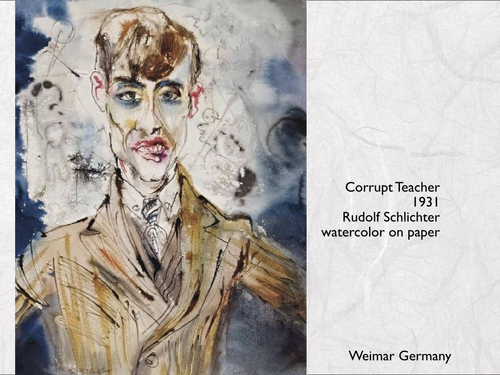












The author is a retired attorney and a still producing artist.
ACTUAL SLIDES ARE ON THIS PAGE FOR YOUR REVIEW.
This is a powerpoint presentation about Magical Realism & Magic Realism Art History.
EXCERPT: OVERVIEW IN BULLET POINTS:
~ Definition of magical realism: art movement of painting in a meticulously realistic style of imaginary or fantastic scenes or images.
~ This movement is called Magical Realism (early years) OR Magic Realism (later years).
~ began in Weimar Germany, then spread to Europe and was ultimately transported to North America.
~ representational art, mixed with elements of fantasy.
~ Magical Realism creates mystery through its details. It occurs in a sterile ambiance in which mystery would normally be lacking.
~ very detailed, sharply focused and emotion fraught
~ everyday world depicted in new and unfamiliar ways with often some hidden or suggestive content in the scene. Surrealism showed the fantastic. Magical Realism did not.
~ Franz Roh coined the term “magical realism” in 1925, in reference to the hidden, mystery element in the painting.
~ The first notable European exhibit was “Die Neue Sachlichkeit (The New Objectivity).”
~ America had its own major exhibition, "American Realists and Magic Realists."
~ Andrew Wyeth was in this show and became the most successful American artist associated with Magic Realism. Wyeth's “Christina’s World” is a very well known Magic Realism painting. The aspect which is hidden is that Christina is not young. She is in her 50s. Plus she is handicapped and cannot walk.
~ Two important North American Magic Realists were George Tooker, American, and Alex Colville, Canadian.
~ Unlike the Surrealists, the original Magical Realists were called the Quiet artists. Their paintings were subtle. They hid important elements instead of being overt.
ACTUAL SLIDES ARE ON THIS PAGE FOR YOUR REVIEW.
This is a powerpoint presentation about Magical Realism & Magic Realism Art History.
EXCERPT: OVERVIEW IN BULLET POINTS:
~ Definition of magical realism: art movement of painting in a meticulously realistic style of imaginary or fantastic scenes or images.
~ This movement is called Magical Realism (early years) OR Magic Realism (later years).
~ began in Weimar Germany, then spread to Europe and was ultimately transported to North America.
~ representational art, mixed with elements of fantasy.
~ Magical Realism creates mystery through its details. It occurs in a sterile ambiance in which mystery would normally be lacking.
~ very detailed, sharply focused and emotion fraught
~ everyday world depicted in new and unfamiliar ways with often some hidden or suggestive content in the scene. Surrealism showed the fantastic. Magical Realism did not.
~ Franz Roh coined the term “magical realism” in 1925, in reference to the hidden, mystery element in the painting.
~ The first notable European exhibit was “Die Neue Sachlichkeit (The New Objectivity).”
~ America had its own major exhibition, "American Realists and Magic Realists."
~ Andrew Wyeth was in this show and became the most successful American artist associated with Magic Realism. Wyeth's “Christina’s World” is a very well known Magic Realism painting. The aspect which is hidden is that Christina is not young. She is in her 50s. Plus she is handicapped and cannot walk.
~ Two important North American Magic Realists were George Tooker, American, and Alex Colville, Canadian.
~ Unlike the Surrealists, the original Magical Realists were called the Quiet artists. Their paintings were subtle. They hid important elements instead of being overt.
Something went wrong, please try again later.
This resource hasn't been reviewed yet
To ensure quality for our reviews, only customers who have purchased this resource can review it
Report this resourceto let us know if it violates our terms and conditions.
Our customer service team will review your report and will be in touch.
$5.00